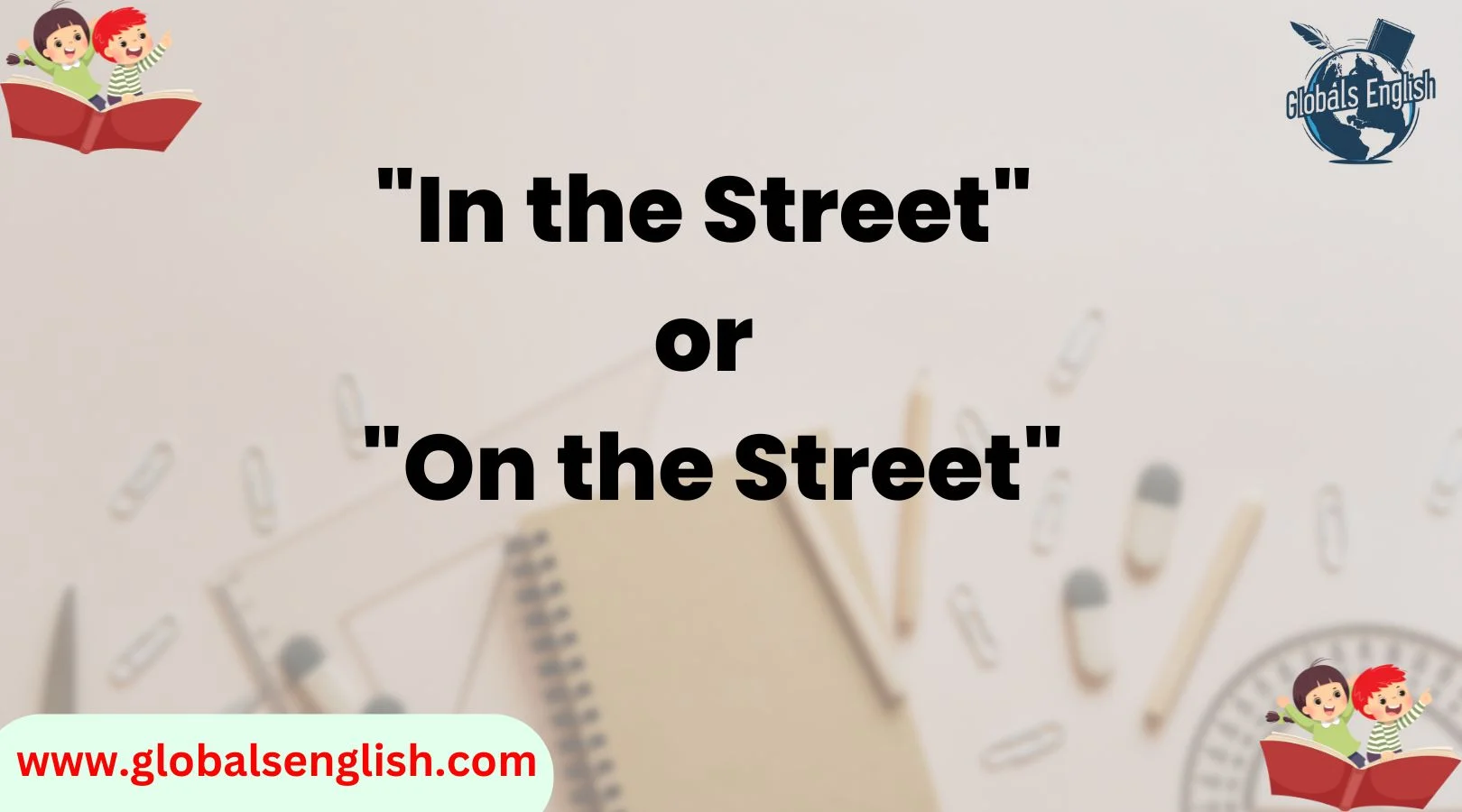Language can be a funny thing, right? Sometimes, we think two phrases mean the same thing, but a small twist of a word changes everything. Take “in the street” and “on the street”—they both sound pretty similar, but trust me, they’re not always interchangeable. If you’ve ever caught yourself wondering which one to use, you’re not alone. And don’t worry, this guide is here to clear up any confusion.
So, let’s dive into this. We’ll explore the real difference between these two expressions, uncover when to use each, and share some real-world examples to make everything click. No fluff, just the straight facts. Grab a seat—this is going to be an interesting ride!
What’s the Big Deal Between “In the Street” and “On the Street”?
You’ve probably heard people say both “in the street” and “on the street” a million times. But do you know when to use each one correctly? It’s not just about grammar, but the specific meaning you want to convey. While both phrases might sound the same at first, they each have their own vibe and context.
Let’s start by breaking down the basic idea of each phrase:
- “In the street” generally refers to being within the actual boundaries of the street. Think of someone who’s walking in the middle of the road, or a car stuck in the street. It’s a bit more about being inside the space of the street itself, where traffic, pedestrians, and all that activity are happening.
- “On the street”, on the other hand, usually refers to being on the surface of the street. You’re not necessarily in the middle of the road—you could be walking on the sidewalk, or standing on the side of the street. It’s a bit more of a general, neutral phrase.
Still with me? Good. Because things get even more interesting when you look at the real-world examples.
When to Use “In the Street”
Think Inside the Street, Literally
“In the street” is what you say when someone or something is physically within the boundaries of the street, often amidst all the hustle and bustle of cars, people, and sometimes even bicycles. If you’re inside the street itself (not standing on the sidewalk or sitting on a bench), you use “in.”
For example:
- “The kids are playing in the street.”
- “I saw a dog running in the street earlier today.”
- “A car broke down in the street, blocking traffic.”
Notice how each example suggests a direct interaction with the street’s space? When something is happening inside the street itself, that’s when you go with “in.”
A Little Danger, Maybe?
Here’s a fun tidbit—“in the street” often has an element of danger or risk tied to it. Think about it: a kid playing in the street is at risk of getting hit by a car, and a dog running around in the street can cause accidents. So, sometimes, it’s not just about being physically in the street, but about what could happen there.
- “Don’t stand in the street—it’s not safe!”
- “There’s a car parked in the street blocking the way.”
When to Use “On the Street”
It’s All About Location, Not Boundaries
Now, let’s talk about “on the street.” This one is a bit more laid back. “On the street” doesn’t always mean you’re actually in the street’s space. It usually refers to being on the surface or near the street.
- “I saw a street performer on the street yesterday.”
- “There’s a cool café on the street by the park.”
- “I live on the street with the big red house.”
Notice how in these examples, the person or object is related to the street, but they aren’t directly in the middle of it. They’re either on the sidewalk or nearby—just connected to the street without being in it.
The Figurative Side of “On the Street”
What’s even cooler is how “on the street” gets used in figures of speech. It’s often used to talk about things like rumors, homelessness, or general street life. For example, when someone says, “word on the street,” they mean rumors or gossip floating around—not that people are physically on the street talking about stuff.
- “I heard on the street that a new restaurant is opening.”
- “He used to live on the street, but now he’s doing much better.”
Breaking It Down: “In” vs. “On”
Still feeling a bit unsure about when to use each phrase? Let me make it clearer for you with a quick checklist:
- Use “in the street” when something is happening inside the street, whether it’s in the middle of the road, a dangerous situation, or an activity that’s part of the street.
- Use “on the street” when you’re simply talking about something or someone being on the surface of the street, such as walking on the sidewalk, standing near the edge, or referring to street names and locations.
Common Mistakes People Make
You’d be surprised how often people mix these up, especially since they sound so similar. Here are some mistakes I hear all the time:
- “I was walking in the street” (when you’re actually on the sidewalk).
- “The kids are playing on the street” (when they’re clearly in the road).
It’s an easy mistake to make, but understanding the difference is important for being clear and precise.
British vs. American English: A Quick Comparison
Fun fact: There’s a slight difference between British and American usage! While Americans typically say “on the street” in most cases, Brits often say “in the street” even when referring to people standing on the sidewalk. It’s a small distinction, but if you’re in the UK, you might hear people say:
- “He was standing in the street waiting for the bus.”
- “They set up a stall in the street to sell their crafts.”
In the US, you’ll likely hear “on the street” in both cases. So, there’s no one-size-fits-all rule—it depends on where you are!
Real-World Examples to Drive It Home
Alright, let’s take a moment to reflect on some real-world situations where you’d use “in the street” and “on the street”:
- “In the street” – Picture a big street race. The runners are running in the street, right in the path of traffic, with the road all to themselves.
- “On the street” – Picture a block party. People are on the street, standing or sitting around the sidewalk, chatting, laughing, and enjoying the event.
See how these scenarios fit each phrase perfectly?
Wrapping It Up
So, the next time you’re wondering whether it’s “in the street” or “on the street”, just remember this simple rule:
- “In the street” is for being inside the space of the road.
- “On the street” is for being on the surface or nearby, like on the sidewalk.
And don’t forget—the key to mastering this is context. Whether you’re crossing the road or just passing by, understanding these phrases will make you sound like a pro in no time.
Now go ahead, impress your friends with your new knowledge of street-speak!
FAQs: “In the Street” vs. “On the Street”
1. Is there a rule for when to use “in the street” vs. “on the street”?
Yes! “In the street” is used when someone or something is physically inside the street, like walking in traffic or playing where cars drive. “On the street” is for things located on or near the street, such as standing on the sidewalk or referring to a street in general.
2. Can “in the street” and “on the street” be used interchangeably?
Not really. They might seem similar, but they have different meanings. Saying “She lives in the street” would sound incorrect unless you’re emphasizing that she is physically in the middle of the road. Instead, “She lives on the street” is correct when referring to homelessness.
3. Which is more common in everyday conversation?
“On the street” is more common because it covers broader meanings—locations, addresses, and even idiomatic expressions like “word on the street.” “In the street” is used less frequently because it usually refers to something happening directly in traffic or inside the roadway.
4. Does British English use “in the street” more often than American English?
Yes! In British English, it’s more common to hear “in the street” even in cases where Americans would say “on the street.” For example, Brits might say, “There were musicians in the street,” while Americans would say, “There were musicians on the street.”
5. How do I remember the difference easily?
Try this simple trick:
- “In the street” → Think of being inside the traffic area (like a car, pedestrian, or obstacle).
- “On the street” → Think of everything else—standing, selling, living, or talking about street names.
Conclusion: The Final Verdict on “In the Street” vs. “On the Street”
At first glance, “in the street” and “on the street” might seem interchangeable, but as we’ve seen, context matters. If you’re talking about something happening inside the space of the street—where cars drive—use “in the street.” If you’re referring to a location near, on the surface, or figuratively related to the street, go with “on the street.”
A quick recap:
- “In the street” = Physically inside the road (e.g., “Kids are playing in the street.” 🚸)
- “On the street” = Located near, on, or related to a street (e.g., “There’s a food truck on the street.” 🌮)
Understanding the difference between these phrases will make your English sound more natural and precise. So next time you’re talking about streets, whether it’s a traffic jam or the latest gossip, you’ll know exactly which phrase to use.

As the visionary founder and CEO of Globals English, Emma Brooke is dedicated to transforming the way individuals learn and master the English language.
